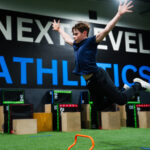Speed and Agility Training in Small Spaces
Limited space doesn’t have to limit your performance. Whether you’re training at home, in a garage, or in a tight gym studio, you can still build elite-level speed and agility. The key is knowing how to adapt your drills for confined areas.
In this article, we’ll explore how to train effectively for speed and agility without needing a full court, turf field, or wide open gym. These small-space workouts will help you stay fast, sharp, and game-ready—anytime, anywhere.
Why Train in Small Spaces?
Most athletes associate speed and agility training with big spaces: tracks, fields, or performance centers. But that’s not always practical.
Here’s when small-space training becomes essential:
-
Offseason home workouts
-
Bad weather conditions
-
Limited access to facilities
-
Rehabilitation or controlled training
-
Travel or remote locations
According to Healthline, small-space home training can be just as effective as traditional workouts when it includes movement, resistance, and structure.
With smart drills, you can still train speed, quickness, and foot control without sacrificing results.
Training Focus in Tight Areas
When space is limited, training needs to be intentional. Focus on these attributes:
1. Foot Speed
You don’t need to run 40 yards to improve how fast your feet move. Fast, repetitive steps build neuromuscular speed.
2. Reaction Time
Quick-reaction drills can be done in place using light cues, sound cues, or partner calls.
3. Acceleration Mechanics
Wall sprints and resistance drills teach forward lean and drive, even in short bursts.
4. Change of Direction
Quick pivots, cuts, and lateral hops can all be done in a 5×5-foot space.
Best Small-Space Speed and Agility Drills
Each of the following drills requires minimal space—most can be done in a 6×6-foot area with little to no equipment.
1. Wall Drive Holds
Focus: Sprint posture and drive mechanics
How: Face a wall, hands at shoulder height, lean forward at 45 degrees. March knees up while staying tall through hips.
Reps: 3 rounds of 15 seconds
2. Quick Step Line Drill
Focus: Foot speed and timing
How: Draw or tape a line on the ground. Step over the line as fast as possible (two feet or single foot).
Variations: Forward-backward, side-to-side, scissors
Reps: 3 sets of 10–15 seconds per variation
3. 180° Reaction Turn
Focus: Change of direction and awareness
How: Stand facing a wall or coach. At a visual or verbal cue, turn 180° and sprint two steps in the opposite direction.
Reps: 3 sets of 6 reps each side
4. Mini Hurdle Quick Hops (or Cones/Socks)
Focus: Plyometric foot control
How: Set up 3–5 objects in a row. Hop laterally or forward/back over them with minimal ground contact.
Reps: 3 rounds of 20 seconds
5. Agility Ladder Footwork (Real or Drawn)
Focus: Agility and rhythm
How: Use a physical ladder or tape one on the floor. Perform fast foot drills like:
-
Two-in each box
-
Ickey shuffle
-
Lateral hop
Reps: 3–4 variations for 2 rounds
Sample At-Home Speed and Agility Session
You don’t need fancy equipment. This sample workout uses bodyweight drills and basic space.
Warm-Up (5 Minutes)
-
Jog in place: 1 min
-
High knees: 30 sec
-
Butt kicks: 30 sec
-
Arm swings + lunges
Main Set (Repeat 2–3 Rounds)
-
Wall drive holds – 15 sec x 2
-
Line hops (forward-back) – 15 sec
-
Reaction turn drill – 6 reps
-
Quick foot ladder drill – 2 variations
-
Mini hurdle hops – 15 sec
-
Rest 60 seconds between rounds
Cool Down (5 Minutes)
-
Walking toe touches
-
Calf stretch
-
Breathing reset
Equipment Suggestions for Tight Areas
While bodyweight is enough, these low-cost items enhance small-space workouts:
-
Mini cones or markers
-
Agility ladder (or tape one)
-
Resistance bands for wall sprints
-
Foam hurdles or household objects
-
Speed apps or timers
Optional: Add a basketball, soccer ball, or tennis ball to integrate ball handling or reflex work.
Tips for Maximizing Small-Space Agility Work
-
Emphasize Intent: Even with less room, move explosively. Every rep should have speed.
-
Track Progress: Time drills or count reps to stay accountable.
-
Keep Rest Short: Small-space workouts are ideal for high-intensity intervals.
-
Rotate Drills Often: Switch up patterns every week to challenge the nervous system.
-
Layer Difficulty: Add visual cues, change movement direction, or increase speed over time.
Who Benefits from Small-Space Speed Training?
Athletes of all levels can use these strategies, but they’re especially useful for:
-
Youth athletes training at home
-
Basketball or volleyball players practicing in garages or driveways
-
Traveling athletes staying sharp in hotel rooms
-
Rehab clients easing back into movement
-
Multi-sport athletes balancing remote and in-person training
Even elite athletes benefit from these simplified, focused sessions when full-scale training isn’t possible.
Training Made Simple and Smart
At Next Level Athletics USA, we understand that not every athlete has access to large facilities year-round. That’s why we build customized speed and agility training plans that work in any environment—big or small.
Our expert programs are perfect for home setups, travel training, or off-season work that keeps you ahead of the competition.
Final Thoughts
Speed and agility training in small spaces is not only possible—it’s powerful. With the right drills, structure, and mindset, you can improve quickness, reaction, and coordination without needing a field or court.
The best athletes don’t make excuses—they adapt. Your performance doesn’t depend on space. It depends on effort.
Train smart. Stay sharp. And make every inch count.


Recent Comments